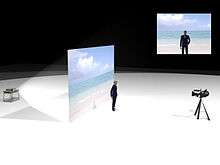Rear projection effect
Rear projection (also known as process photography) is part of many in-camera effects cinematic techniques in film production for combining foreground performances with pre-filmed backgrounds. It was widely used for many years in driving scenes, or to show other forms of "distant" background motion.
Technique

The actors stand in front of a screen while a projector positioned behind the screen casts a reversed image of the background. This required a large space, as the projector had to be placed some distance from the back of the screen. Frequently the background image would appear faint and washed out compared to the foreground. The image that is projected can be still or moving, but is always called the plate. One might hear the command "Roll plate," to instruct stage crew to begin projecting.
These so-called process shots were widely used to film actors as if they were inside a moving vehicle, who were, in reality, in a vehicle mock-up on a soundstage. In these cases the motion of the backdrop film and foreground actors and props were often different due to the lack of steadicam-like imaging from the moving vehicles used to produce the plate. This was most noticeable as bumps and jarring motions of the background image that would not be duplicated by the actors.
A major advance over rear projection is front projection, which uses a special screen material to allow the plate to be projected from the front of the screen. This results in a much sharper and more saturated image. Although the technique had been used experimentally for some time, it was during the filming of 2001: A Space Odyssey that the modern version was fully developed. In this case it was used to avoid costly on-location shots in Africa during the opening scenes of the movie, but the effect was also used throughout the film for a variety of shots into or out of the windows of spacecraft. 2001 also used rear projection to produce computer screen effects.
As front projection and bluescreen effects became more widespread and less costly, rear projection has been rendered largely obsolete. Quentin Tarantino used the process for the taxi ride sequence of Pulp Fiction, and James Cameron used rear projection for several special effects shots within Aliens, including the crash of the dropship as well as for several important sequences in Terminator 2: Judgement Day such as the car escape from the mental hospital and the T-1000 hijacking the Police helicopter; he has been described as one of the few people in Hollywood still able to understand and use process photography as an effective technique.[1] Also, the Austin Powers film series frequently used rear projection to help give it the feel of old spy movies; Natural Born Killers used the technique extensively throughout to emphasize characters' subconscious motivations.
History
Rear projection was conceived long before its actual usage; however, it was only made possible in the 1930s due to three necessary technical developments. The most important was the development of camera and projector motors which could be linked up for synchronization of their shutters, which were developed out of the unrelated needs of "talking" movies whose timing had to be carefully controlled. Secondly, Eastman Kodak's introduction of panchromatic film stock in 1928 allowed for the camera to expose the projected background more than orthochromatic stocks, making it look less faint than it did before. Finally, the larger film gauges beginning to emerge in the late 1920s demanded more powerful projection lamps, which were subsequently available for making the rear projection screen brighter and thus more properly exposed.
Fox Film Corporation was the first to use the rear projection technique, in 1930 with their films Liliom and then Just Imagine, and were subsequently awarded a technical Oscar for their work the next year. Shortly after this debut, Farciot Edouart ASC, at Paramount Pictures, refined the technique starting in 1933, and developed several new methods, such as syncing three projectors with the same background plate for more even and bright exposure. Linwood Dunn ASC, at RKO Radio Pictures, expanded on this with the use of traveling matte with films like Flying Down to Rio (1933). The American made version of 'Saint Joan of Arc" was the first movie created with the advent of "The Hansard Process" one of the pioneers in Rear Screen Special Processing. The Tornado in the Wizard of Oz was created by "The Hansard Process" technology and company.
Alfred Hitchcock used the process successfully to show Cary Grant being attacked by a crop duster plane in North by Northwest, but was criticized when he used it extensively in Marnie.
See also
- Bipack
- Optical printer "The Hansard Process"
- Schüfftan process
- Traveling matte
Notes
- ↑ Terminator 2: Judgement Day Ultimate Edition DVD special features, interview with James Cameron on 'Process Photography'
References
- Clarke, Charles G., A.S.C, Professional Cinematography, Los Angeles, 1964, pp. 153 ff.